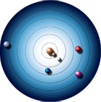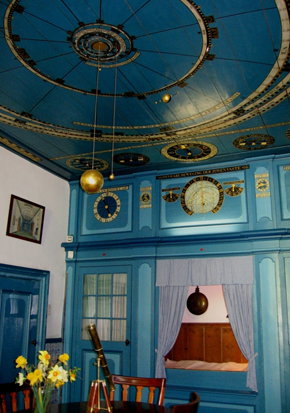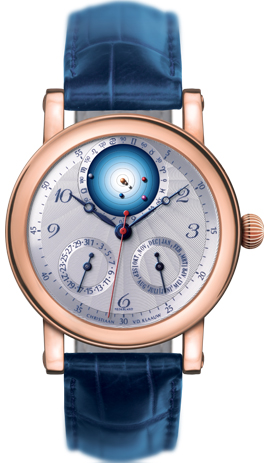|
Today, in the professional environment the name of a talented watchmaker Christiaan van de Klauw is known to all thanks to his unique and highly complex astronomical wristwatches. The concept of the astronomical watch says that in such time meter are reflected the most advanced features. The most famous model created by Christiaan van de Klauw is a unique watch The Planetarium, which has already turned into a collection with unusual and complex models.
Passion of the talented watchmaker Christiaan van de Klauw to the beauty of the sky was embodied in a small planetarium, which is one of the most famous works of the master. This masterpiece is a carrier of the exceptional accuracy and traditional handicrafts. This watch is equipped with the smallest planetarium in the world and it shows not only the time, date and month, but the orbit of Mercury, Venus, Earth, Mars, Jupiter and Saturn around the Sun. A man, passionate by astronomy or just an amateur of complex and unusual, of course, will like this planetarium, because to know the location of the planets in relation to the Sun at any time is a quite attractive temptation.
History of the planetarium!
 The first written record relating The first written record relating to the mechanical model of the Sun, Moon and planets, takes us back to 2000 years ago. The instrument described in the paper was invented by Archimedes, who lived for 200 years. From the time there were invented many astronomical time meters. Between the time of the invention of the oldest planetarium – a planetarium of Archimedes and the smallest planetarium of Christiaan de Klauw were invented many magnificent examples with ingenious design, which, perhaps, that is worth to be mentioned. to the mechanical model of the Sun, Moon and planets, takes us back to 2000 years ago. The instrument described in the paper was invented by Archimedes, who lived for 200 years. From the time there were invented many astronomical time meters. Between the time of the invention of the oldest planetarium – a planetarium of Archimedes and the smallest planetarium of Christiaan de Klauw were invented many magnificent examples with ingenious design, which, perhaps, that is worth to be mentioned.
The above masterpiece of Archimedes - is brilliant and unique example of human imagination and thought. This tool is known as the "Antikythera Mechanism". Its unusual name, this mechanism was given in honor of the Greek island of Antikythera, near which in 1902, divers found a fragment of this instrument. The mechanism consists of a large number of bronze gears enclosed in a wooden case, which was attended by dials with hands. The case was designed to calculate the motion of heavenly bodies. In this computing device was used differential gear, which, as was previously considered to be invented only around in XVI century, and the level of miniaturization and complexity is comparable to mechanical watches XVIII century. The approximate size of the mechanism in assembly is 33 × 18 × 10 cm. At that time it was geocentric understanding of the universe, which means that the center of the universe is our planet and the Sun and the Moon and other planets revolve around it. This theory is known as the geocentric theory of Ptolemy. Surprising is the fact that this theory has been popular for a long time. Perhaps the reason for this was that it was possible to easily and accurately make predictions about the position of the Sun, Moon and planets.
The end of this theory came in 1543, when Nicholas Copernicus proposed his theory, which was completely the opposite of the geocentric. The new theory met a violent resistance in the first place from the church. In his published theory he argued that the Earth is not the center, but the sun, around which revolve all the planets, including our own. His theory is called the heliocentric (after the Greek god of Sun Helios). After Johannes Kepler (1571 - 1630), who is the founder of modern astronomy, the creation of planetarium became much easier. At this time the known planetarium was a planetarium of a Dutch physicist Christian Huygens (1629-1695). He placed the gears that control the movement of the planets, eccentrically to the center. Thus, the position of the planets was indicated fairly accurate. Planets move in accordance with the second law of Kepler. There are a number of planetariums, worthy of attention, such as the planetarium of a Dutch amateur astronomer Eise Eisinga (1744 - 1828), which became a major source of inspiration for the talented master Christiaan van de Klauw. The planetarium of Eisinga was created in the period from 1774 to 1781, and 200 years later it still operates, which makes it the oldest operating planetarium in the world. Some of the masterpieces of Christiaan van de Klauw can be found in the museum of Eise Eisinga.
The Planetarium
 At the end of the 90th's Christiaan van de Klauw developed a model of one of the most ingenious watches The Planetarium. As already mentioned above, inspired by the works of such astronomers as Christian Huygens and Eice Eysinga, he managed to create a miniature planetarium, successfully placed on a watch. The planetarium of Christiaan van de Klauw has become the smallest planetarium in the world. At the end of the 90th's Christiaan van de Klauw developed a model of one of the most ingenious watches The Planetarium. As already mentioned above, inspired by the works of such astronomers as Christian Huygens and Eice Eysinga, he managed to create a miniature planetarium, successfully placed on a watch. The planetarium of Christiaan van de Klauw has become the smallest planetarium in the world.
This collection consists of several models that are differ by only of the used various materials to create cases as well as by the design of dial. However, for clarity, it should be described at least one model, such as CK planetarium KPT1126. This is a classic in its execution model that all fans of unique and exeptional will appreciate. The flawless round watch case with diameter of 40 mm is made of pink gold. The white dial with blue indexes and lacquered planetarium with colorful planets is protected by durable sapphire crystal with anti-reflective coating. The blue hands are made of blued steel. The case back is also covered by a sapphire crystal, through which can be seen fascinating work of the internal mechanism. The clock is provided by a modified self-winding and integrated planetary module CK 1196. The mechanism provides the following functions: miniature heliocentric planetarium, the time, date, and month as well as the position of Mercury, Venus, Earth, Mars, Jupiter and Saturn related to the Sun. The blue strap, which is harmonious completion of the general look of this astronomical watch and is in harmony with the dial which is made of alligator skin. The strap is equipped with a secure clasp in rose gold, on which is engraved the company’s logo. This model is kind of beauty of the sky, which is presented in a beautiful combination of white and blue, as well as the presence of a miniature planetarium. Unique models of this collection, as well as all the rest - are the real collectors' pieces. Undoubtedly, Christiaan van de Klauw is among the greatest and most talented watchmakers whose works excite the imagination as watch amateurs and professionals.
|
